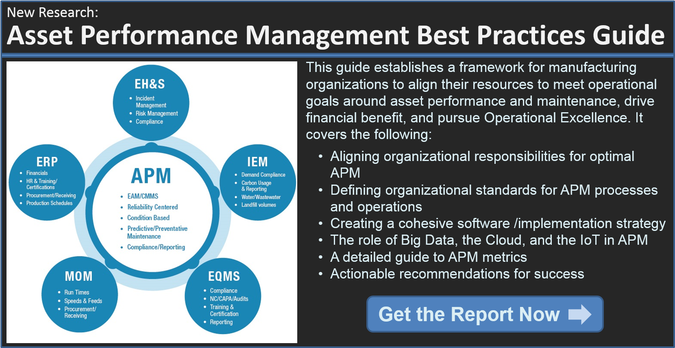As we close out 2014 amid the holiday season and are in the process of launching our Asset Performance Management (APM) practice shortly after the first of the new year, I’d like to offer season's greetings and a New Year's wish to all of our blog readers that are becoming part of our APM Community.
There are a lot of things I could wish for you in 2015--increased uptime, higher reliability, better data, strong management support, and many more--but instead I wish for all in the LNS Research APM research Community the following: In 2015 may all your devices be smart and connected!
Smart, connected devices are the key that unlocks the door to the APM kingdom
All of the wishes like uptime, reliability, and better data can be enabled by smart, connected devices. As we have posted in several of the latest APM-related blog articles, including our predictions for 2015, the data generated by the smart, connected devices are already serving as the one best examples vendors are citing regarding the value of the IoT.
In case after case, whether it is energy efficiency, utility waste reduction, or increased reliability and the concurrent reduced downtime that results, leveraging information from smart and connected devices is the underlying factor. The more information you have the better the decision you can make.
Obviously there is a cost to ever-increasing amounts of data, but the trick is to ensure that the value you are deriving from that information exceeds the cost of acquisition. As long as you keep that underlying principle in mind, you will be making strides towards Operational Excellence when it comes to your asset performance.
It's about being smart and connected; not who owns the technology
There is a lot of talk in industry today about IT versus OT, IT/OT convergence, or IT and OT where IT is your classic information technology and OT is operational technology. While every company seems to draw the IT-OT dividing line somewhat differently, the most common differentiator seems to be who owns and supports the technology and which vendor provides the technology.
While this discussion certainly has implications for most users in that it helps define roles and responsibilities for technology support in the enterprise, it really doesn’t add a whole lot of value when it comes to what the technology delivers to the enterprise.
Being smart and being able to generate data about the state of the process and the equipment is the key. Of course, using that data to effect actions that use that information to improve or maintain the process at optimum operating conditions is also important. Without either element, being both smart and connected, you really don’t gain much. In fact much of OT throughout the past was not smart or connected but it was OT nevertheless.
A solid-state controller that took a single input and used it to control a single end-point device was clearly OT owned by operations and supported by plant staff. It is just that particular OT was not really contributing much other than acting as a single loop of control. It is only when these devices from the sensor to the controller and the actuator started to become smart did we start to see the potential for enhanced performance.
And once we connected these devices via networks so more devices and applications could use that information, we began to see significant leaps in the speed in which we could recognize issues in the processes and equipment as well as respond to them.
The IT-OT issue does have relevance
Every organization needs to realize that there is technology that is owned, operated, and supported by the IT function and there is technology that is owned, supported and operated by operations, and there will even be mixes of these where operations may own the technology and operate it but IT provides support.
These are all important delineations that need to be understood and every enterprise needs to make sure that the demarcations they put in place work for them. At the same time it needs to recognize that both the IT and operations groups will have both smart and connected devices and likely some not-so-smart devices, and in the case of operations likely some not-connected devices as well.
They need care and nurturing as well. Just don’t confuse the IT-OT debate as adding value to your processes other than ensuring the devices you do have are properly supported.
It's about the connection of smart devices to a larger universe
We have said many times that the real value going forward will be in using all the data being generated with analytics, sharing it in the cloud in various forms and leveraging it across multiple applications. It is for this reason I reiterate my wish for the APM community in 2015: May all your devices be smart and connected!
